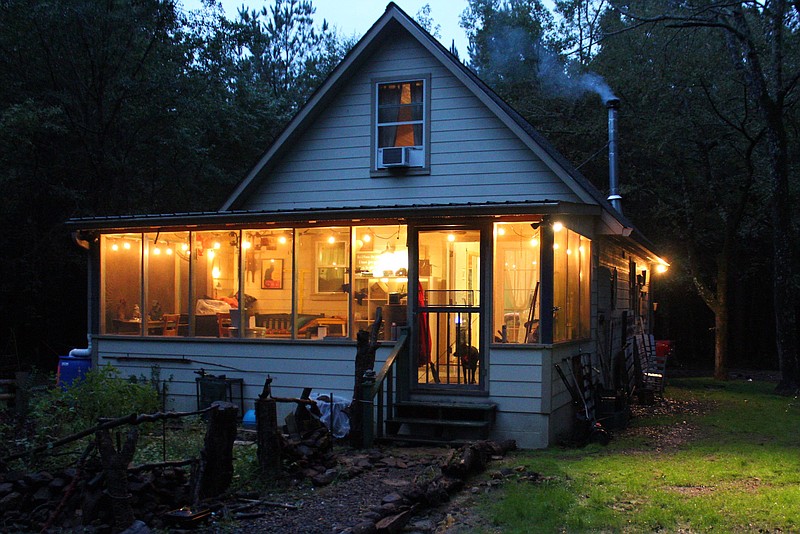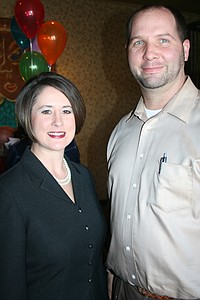A little more than a year ago, Dr. C. Jason Smith was a tenured English professor at LaGuardia College in New York City, living in a high-rise apartment with a view of the Hudson River. A published author (three books in the science fiction genre), an expert in science fiction films and novels, feminist literature, and about the life and works of author Robert Penn Warren, Smith daily enjoyed the excitement, convenience and historical context of the Big Apple.
Until one day, he didn't.
Photo Gallery
MDA Lock-Up
A jail-themed telethon for the Muscular Dystrophy Association held at 1620 Restaurant April 1.
A lover of literature and history with a Ph.D. in Comparative Literature from the University of Arkansas-Fayetteville, he had access to some of the world's best libraries and museums, including the New York City Public Library, Guggenheim Museum and The Metropolitan Museum of Art.
The U.S. Army veteran is a gourmet cook and enjoyed the atmosphere of a city where you could walk a block or two to markets brimming with items hard to find in other areas of the country: mozzarella cheese so fresh it was still dripping juice, mushrooms fresh-picked from cellar gardens in the city, and an endless array of spices from throughout the world.
Then, one day, he no longer wanted to teach, no longer enjoyed the hustle and bustle of a 24-hour city, no longer felt comfortable at a job that was getting more and more stressful.
What to do? Where to go? This is his story.
Q: You moved from New York City to the Sutton community in rural Nevada County, Ark. Why the community of Sutton?
A: Sutton, which is about midway between Hope and Prescott just off State Highway 73, is my family home place on my grandmother's side: the Andres family. My great-grandparents, "Daddy George" Andres and "Nanny" Mattie Andres, were still living when I was a kid and we spent a lot of time in their little house on what was once platted out as Third Street.
All of us cousins were there for holidays and spent time there every summer. We roamed the woods when I was a kid, and of course, at that time, the adults let the kids pretty much do what we wanted as long as we did not set anything on fire, drown, or get shot. I loved it. So, when my father, George Smith, and his wife Bobbie, who owned 16 acres of the original 100-acre tract, offered me the chance to build on a little piece of land near the old house, I jumped at the chance.
At first I imagined just a vacation cabin, and maybe a permanent residence for retirement. The original idea was for a very small place, a "tiny house" of one or two rooms, but it sort of kept growing square foot by square foot, and as the house "grew up," so to speak, my desire to live there full time grew as well.
The house is built on the site of a two-room house that was used by family members and sharecroppers and later became a place to store root vegetables. It was made of cypress and was no longer habitable.
Q: Concerning the move, any culture shock?
A: Well, I lived in New York City for about 17 years. So, yes. It was more than a bit of a culture shock-it was a huge shock. I had not driven more than two or three times a year for that long. I did not even own a car. I either walked to the grocery store or had groceries delivered. Suddenly I had this red, four-door Dodge pickup and had to drive to Hope or Prescott even if all I needed was milk. It is not a long drive either way, 15 minutes or so, but it seems much longer when you are not used to country roads.
Q: What was the hardest thing to get used to after the move?
A: The quiet. It took quite a while for my brain to start processing the sounds of the woods and wind as actual sounds. I was so used to ignoring the incessant background noise of the city that I could not "hear" the crickets and owls. That came back to me very slowly, being able to "hear" the animals and wind. Now I find it quite noisy, particularly with my hen that turned out to be a rooster crowing at 6 a.m.
Q: You are adamant that your house is not a "tiny" house but is actually a "small" house. What's the difference?
A: A "tiny" house is generally one room, perhaps with a loft. Often they are on wheels, a "mobile home," but looking like a teensy house. My cabin, as a concept, was always going to be "alpine" style with the high pitched roof and a loft, but the square footage shot up as I thought about actually living in it; there were certain things I wanted that a "tiny house" of 400 square feet or so could not accommodate. However, I did utilize my experience living in apartments in NYC to maximize the use of space. An over-under washer and dryer, for example, and a galley kitchen with open shelving rather than cabinets. But I also wanted a clawfoot cast iron tub. You are not getting that into a "tiny house." No way.
Q: With you finishing up your duties as a college professor, how did you build a house 2,000 miles away?
A: My father and step-mother supervised the on-site work and sent me pictures all the time. They live about 100 yards away through the woods and were really the contractors. They had to make a lot of decisions on the spot and I trusted them to do that.
Q: What features do you like the best in the house?
A: The modified A-frame, or "alpine" slant to the roof and glass front, make it feel much bigger than it really is. I have a front and back deck, the back is screened in, adding to the usable space, weather permitting. All appliances are built in, including the fridge, which fit nicely under the stairs, so that the whole space is easy to navigate without running into things. We made the decision to invest in a tankless water heater and go with propane for the kitchen stove as well-both very good calls.
Q: What are common comments when people first see the house?
A: Well, my great aunt Wanda Collins, who also lives about 100 yards away, calls it the "chalet." It certainly does not look like a typical farmhouse. I get "Wow!" a lot when people see it. It has a bit of church look to it that I did not consciously think of when getting the plans, but it must have been in the back of my head somewhere. The front really does look like a chapel.
Q: Having lived in it for more than a year, what about the house or floor plan like or would you change?
A: The stairs to the loft are steep and a bit narrow, but that was probably unavoidable. The AC we put in is a hotel-style model placed high up on the wall, which works great, but if the bedroom door is closed (which we do when I have guests) the bedroom gets no heat, nor air. Also, I love the wood burning stove, but when that sucker is going full tilt it is Sahara-hot in the loft. The ceiling fans help, but I have had to open all the doors and windows in the dead of winter more than once.
Q: Anything you would add to the house?
A: We will be adding AC in the bedroom. I have already made a few additions: I put shelves in under the stairs, for example, but more shelves built into the walls is something we could have handled from the get-go from the "tiny house" idea. We got it right in the loft where all available "attic space" from the A-frame roof was converted into shelves and open storage.
Q: What advice would you give to people thinking about downsizing?
A: If you have not touched it in a year or more, you do not need it. I gave away a ton of clothes and reduced my books from more than 2,000 to less than 200. Now it is "one in, one out, no exceptions." I cheated a bit by getting a Kindle for things like classics, Shakespeare and whatnot, that would take up a lot of space.
Q: In any house, storage space is always a problem. How did you handle that situation?
A: Storage is built in just about everywhere. What usually would be "dead space" in internal walls was left open and finished out as storage. I have "hidey holes" all over the house, even under the stairs. Converting the wall space adjacent to and high above the stairs into bookshelves is on my list for the future.
Q: What do you miss most about New York City?
A: Food. I love to cook and I also love to eat out. My apartment in NYC had 30 or more restaurants within walking distance: Greek, Italian, Thai, Japanese, even a Cajun place, you name it, and all really good because of the steep competition. Of course I have to mention the obvious, because it is true: pizza and bagels. I have actually ordered bagels and lox delivered to Sutton from my favorite shop in the Lower East Side.
I also cook almost every day, and like a wide variety of things, from soul food to Mongolian, so I miss the variety of grocery stores, butchers, and bakeries. My butcher would take me back into the cooler and cut exactly what I wanted off of the whole cow. Osso Bucco (pork shank) eight inches across? No problem. I could get venison and game birds (one place had them live). But not squirrels. No problem; the woods around my cabin are alive with them.
Q: What do you like best about living in the woods?
A: I suppose saying "I have an acre-and-a-half of bathroom space would be an inappropriate thing to say. So, I love mornings and my two rescue dogs and my chickens and watching things grow. I have to write a lot as a freelancer to support my "tiny farm" habit. I do love digging in the dirt.
Q: How do you keep yourself busy?
A: Oh, dear Lord! Once I started "farming" a bit, I always have something that needs to be done. I do intensive farming, so it looks like a large garden, but produces as much as other methods produce in a 1/2 acre, but it takes a lot of work and attention. My herb garden really took off. This was my first full year planting, so I had no idea what would grow in my soil after the construction of the cabin, so I decided on a shotgun approach and planted a bunch of different things. The herb garden went nuts; I had (and still have) so much basil (sweet, Italian, and purple) that I have made three cases of pesto which I froze to sell at farmers' markets. Kale, collards, and mustard greens also grew really well as did red potatoes and heritage vine tomatoes. Corn and pole beans both washed out twice. I'm learning.
And I bought a used tractor. You never know you need a tractor with a front-loader until you have one. That thing keeps me busy for sure.
Q: Any words of wisdom following your experience?
A: Traveling afar is a great thing when you realize all roads lead to home.


